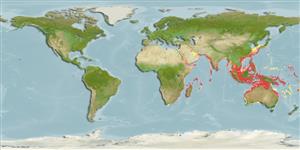>
Scombriformes (Mackerels) >
Scombridae (Mackerels, tunas, bonitos) > Scombrinae
Etymology: Rastrelliger: Latin, rastra = rake + Latin, gero = to carry.
More on author: Cuvier.
Environment: milieu / climate zone / depth range / distribution range
Οικολογία
Θαλασσινό(ά); ωκεανόδρομο(ς) (Ref. 51243); εύρος βάθους 20 - 90 m (Ref. 12260). Tropical; 17°C - ? (Ref. 54861); 38°N - 36°S, 20°E - 180°E (Ref. 54861)
Indo-West Pacific: Red Sea and East Africa to Indonesia, north to the Ryukyu Islands and China, south to Australia, Melanesia and Samoa. Entered the eastern Mediterranean Sea through the Suez Canal.
Length at first maturity / Μέγεθος / Βάρος / Age
Maturity: Lm 21.0, range 17 - 24.5 cm
Max length : 36.0 cm αρσενικό/απροσδιόριστο; (Ref. 111654); 42.1 cm TL (female); common length : 25.0 cm TL αρσενικό/απροσδιόριστο; (Ref. 30573); μεγ. δημοσιευμένο βάρος: 0.00 g; μεγ. αναφερόμενη ηλικία: 4 έτη (Ref. 168)
Ραχιαίες άκανθες (συνολικά) : 8 - 11; Μαλακές ραχιαίες ακτίνες (συνολικά) : 12; Εδρικές άκανθες: 0; Μαλακές εδρικές ακτίνες: 12. Head longer than body depth. Maxilla partly concealed, covered by lachrymal bone but extending to about hind margin of eye. Bristles on longest gill raker 105 on one side in specimens of 12.7 cm, 140 in 16 cm, and 160 in 19 cm fork length specimens. A black spot on body near lower margin of pectoral fin. Interpelvic process small and single. Swim bladder present. Anal spine rudimentary.
Adults occur in coastal bays, harbors and deep lagoons, usually in some turbid plankton-rich waters. Form schools. Feed on phytoplankton (diatoms) and small zooplankton (cladocerans, ostracods, larval polychaetes, etc.) (Ref. 9684). Small groups were seen eating eggs of Cheilio inermis straight after spawning (Ref. 48637). Adult individuals feed on macroplankton such as larval shrimps and fish. Eggs and larvae are pelagic (Ref. 6769). Generally marketed fresh, frozen, canned, dried-salted, and smoked; also made into fish sauce (Ref. 9684).
Collette, B.B. and C.E. Nauen, 1983. FAO Species Catalogue. Vol. 2. Scombrids of the world. An annotated and illustrated catalogue of tunas, mackerels, bonitos and related species known to date. Rome: FAO. FAO Fish. Synop. 125(2):137 p. (Ref. 168)
IUCN Red List Status (Ref. 130435)
Threat to humans
Harmless
Human uses
αλιεία: πολύ εμπορικό; αλιεία αναψυχής: ναί; δόλωμα: occasionally
Εργαλεία
Special reports
Download XML
Διαδικτυακές πηγές
Estimates based on models
Preferred temperature (Ref.
123201): 23.7 - 28.3, mean 27.3 °C (based on 491 cells).
Phylogenetic diversity index (Ref.
82804): PD
50 = 0.6250 [Uniqueness, from 0.5 = low to 2.0 = high].
Bayesian length-weight: a=0.00871 (0.00767 - 0.00989), b=3.07 (3.04 - 3.10), in cm total length, based on LWR estimates for this species (Ref.
93245).
Τροφικό Επίπεδο (Ref.
69278): 3.3 ±0.38 se; based on food items.
Generation time: 1.1 (0.9 - 1.2) years. Estimated as median ln(3)/K based on 81
growth studies.
Ελαστικότητα (Ref.
120179): Μεσαίο(α), ελάχιστος χρόνος για διπλασιασμό πληθυσμού 1,4 - 4,4 έτη (K=0.2-1.9; tm=0.5-1; tmax=4; Fec = 37,690).
Prior r = 0.62, 95% CL = 0.41 - 0.93, Based on 1 full stock assessment.
Fishing Vulnerability (Ref.
59153): Low vulnerability (17 of 100).
Climate Vulnerability (Ref.
125649): Moderate to high vulnerability (52 of 100).
Nutrients (Ref.
124155): Calcium = 200 [75, 539] mg/100g; Iron = 3.28 [1.58, 6.56] mg/100g; Protein = 20.6 [19.4, 21.9] %; Omega3 = 0.32 [0.15, 0.67] g/100g; Selenium = 47.6 [16.2, 153.7] μg/100g; VitaminA = 22.8 [6.0, 89.3] μg/100g; Zinc = 1.24 [0.67, 3.18] mg/100g (wet weight); based on
nutrient studies.
